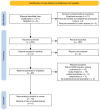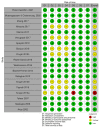Determinants and Effects of Vitamin D Supplementation in Postmenopausal Women: A Systematic Review
- PMID: 36771392
- PMCID: PMC9919965
- DOI: 10.3390/nu15030685
Determinants and Effects of Vitamin D Supplementation in Postmenopausal Women: A Systematic Review
Abstract
Hormonal fluctuations, excessive clothing covering, sunscreen use, changes in body fat composition, a vitamin D-deficient diet, and a sedentary lifestyle can all predispose postmenopausal women to vitamin D deficiency. An effective supplementation plan requires a thorough understanding of underlying factors to achieve the desired therapeutic concentrations. The objective of this study was to conduct a systematic review of the predictors that affect vitamin D status in postmenopausal women. From inception to October 2022, we searched MEDLINE, Embase, Web of Science, Scopus, and clinical trial registries. Randomized clinical trials of postmenopausal women taking supplements of vitamin D with serum 25-hydroxyvitamin D (25(OH)D) measurement as the trial outcome were included. Two independent reviewers screened selected studies for full-text review. The final assessment covered 19 trials within 13 nations with participants aged 51 to 78. Vitamin D supplementation from dietary and pharmaceutical sources significantly increased serum 25(OH)D to optimal levels. Lower baseline serum 25(OH)D, lighter skin color, longer treatment duration, and prolonged skin exposure were all associated with a better response to vitamin D supplementation in postmenopausal women.
Keywords: 1,25(OH)D; 25-hydroxyvitamin; menopause; nutrients; vitamin D deficiency; vitamin D status.
Conflict of interest statement
The authors have no conflict of interest associated with the material presented in this paper.
Figures
References
Publication types
MeSH terms
Substances
LinkOut - more resources
Full Text Sources
Medical



